User acquisition got a more sustainable upgrade, and it’s building heat. The product flywheel model is taking Dave McClure’s AARRR pirate metrics and giving them a makeover that rivals Airbnb's rebrand.
Product flywheels are taking a firm foothold in most product-led SaaS businesses today, creating a user adoption and retention strategy that feeds itself.
In this article, we’ll run you through flywheel examples and the steps you can take to build and implement your own. Let’s get rolling.
A product flywheel is a product-led growth framework for self-serve and sustainable acquisition growth focused on the user’s product experience.
Every SaaS product flywheel will look a little different. However, the common goal is to create product champions to win more product-qualified leads and get the wheel spinning.
To create your own flywheel, you’ll need to align on PLG goals, map key stages in your user journey, and segment your users with product data.
Set your flywheel in motion by communicating product value at the right time for each of the user segments and delivering personalized in-app experiences.
What is a product flywheel?
A product-led growth flywheel is a user acquisition method that PLG-oriented businesses use instead of the traditional sales funnel method.
Whereas a funnel uses sales and marketing tactics to attract new users, a flywheel focuses on giving product led user experience and apply user engagement tactics to get current users to attract new ones.
Flywheel vs. Funnel: Which model should you use?
The flywheel is the best option for product-led growth companies. It allows you to invest your time and resources in improving the in-product experience to rely on your current user base to help bring in new customers.
The funnel is a better fit for marketing-led or sales-led SaaS businesses that want to assign resources to user acquisition through solid marketing campaigns and sales flows. `The funnel can be AARRR or RARRA, depending on whether the focus is on acquisition or retention.
The biggest benefit of the flywheel—and the reason why many PLG organizations are turning to this model—is that investing in your product is a more long-term investment. In the long run, it tends to be more effective than pumping money into short-burst campaigns or relying on tricky-to-scale sales tactics.
Now we’ve got the ball rolling, let’s get into some flywheel examples for you to consider in your SaaS, to drive customer satisfaction up and win product-qualified leads from your current user base.
Product flywheel examples for your inspiration
Take a look at the existing product-led growth flywheel frameworks and playbooks to find inspiration and get started working on your own more efficiently.
Example #1: Product flywheel by HubSpot
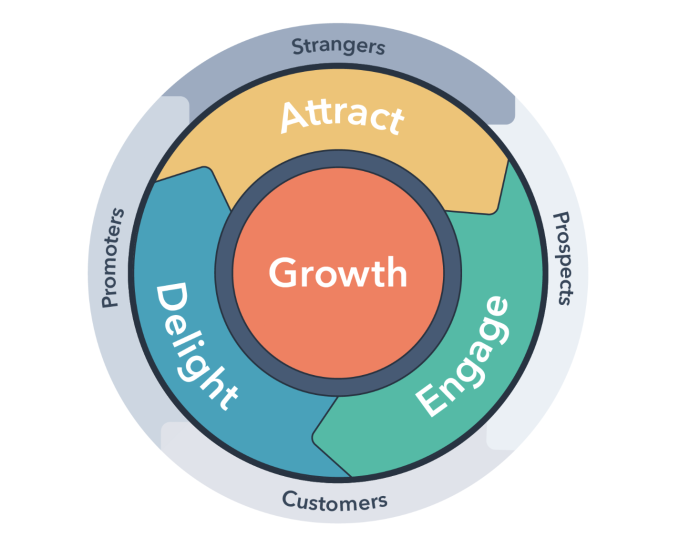
In the HubSpot flywheel framework, the key stages are Attract, Engage, and Delight; with Growth in the middle. HubSpot’s key user segments in this inbound marketing methodology are Strangers, Prospects, Customers, and Promoters.
As HubSpot explains, something to keep in mind is “flywheel friction”. Essentially, your SaaS needs to identify the areas of the wheel that are causing friction to the trajectory of your business.
Here’s how Jon Dick, Senior VP of Marketing at HubSpot, puts it.
“Friction kills flywheels. We’ve made investments that systematically target our biggest points of friction. Great free software as an entry point, channels that help people connect now instead of later, a sales process that solves for prospects, and a broad range of customer education.”
– Jon Dick, Senior VP of Marketing at HubSpot
Example #2: Flywheel framework by Appcues
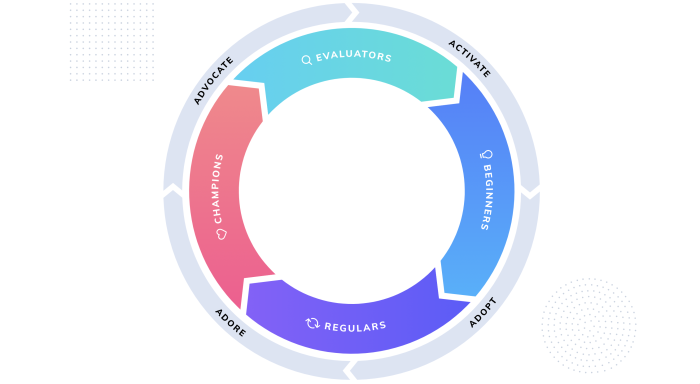
Another well-known PLG flywheel example is the one created by the team at Appcues. As explained by Eric Keating, VP of Marketing, they interviewed 100 companies to help create and validate this framework.
What their team found is that no matter which business function their interviewees were in, whether sales, marketing, or product, everyone was leaning on a product-oriented approach to hit their growth goals.
The result was the wheel that works in four stages: Activate, Adopt, Adore, and Advocate. These stages rely on four user segments to keep the wheel turning: Evaluators, Beginners, Regulars, and Champions.
Each of these flywheel stages and segments will have its own strategy in order to hand users over to the next ‘chapter’ of the wheel.
Example #3: Flywheel Playbook by Amplitude
As Amplitude puts it, the PLG flywheel is an “ongoing virtuous loop that identifies the motions and events driving your product strategy”.
To help product teams think through and create their own flywheels, they’ve put together the Flywheels Playbook with guiding tips, industry-specific examples, and worksheets to help product teams think through and create their own flywheels.
Below is an example of Amplitude’s flywheel worksheet. So, gather your team for a brainstorming session and use it to ask the right questions, identify data points you need to understand, and segment users based on the insights.
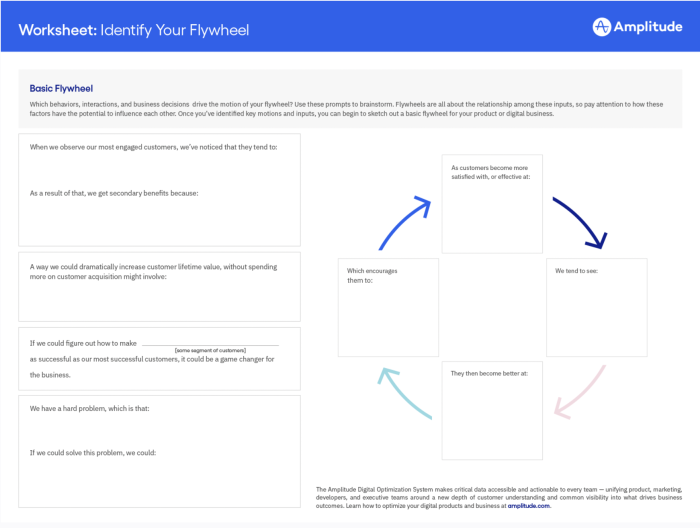
To go a step further, you can integrate Amplitude with Chameleon as a product adoption tool. This way, you’ll be able to use product analytics data to create more effective product tours and in-app guides based on user behavior.
How to build your own flywheel to match your goals
Your product flywheel won’t make sense if you simply copy and paste someone else’s. Every flywheel turns a little differently. It depends on your product-market fit, your user base, your go-to-market strategy, and your current resources.
Let’s explore ways you can create your own flywheel to match your growth goals.
Define your PLG goals
First, align on what your growth goals are. Typically, product teams are used to creating quarterly goals. For example, launch X, Y, and Z features.
However, we want to take things a step further and align your product-led growth goals with your product vision and product adoption strategy. When you take this holistic approach to your business growth goals, you’ll be able to set some KPIs around it.
From these KPIs, you’ll have a clear idea of what your product should (and will) look like and can start to identify the outer ring of your flywheel around onboarding, activation, adoption, and advocacy.
Identify key stages of your user journey
Try to identify key stages of your user journey by asking these questions:
Where are people currently activating in your product?
What does your ”aha!” moment look like?
Is there a common churn point?
What’s the average time to value (TTV), and why?
Identifying these stages in your customer journey will help you pin them on the wheel and align with your inner wheel which would be around evaluators, new users, active users, engaged users, and product champions.
Create data-backed user segments
Lastly, it’s time to segment your users based on their needs. Not every user will need to experience a certain moment within your product to move on to the next stage of the flywheel.
User needs, as we all know, remain fickle and different. What one user may need to experience to become a champion of your product, another may not.
Your wheel will look different for different types of users, so it’s important to segment personas while ensuring your flywheel growth is sustainable and open to automation.
Once you've identified your goals, stages of the user journey, and user segments, you’re ready to set your flywheel in motion and apply it to your growth strategy.
5 steps to set your product-led flywheel in motion
You’re now entering the final stage of this product growth strategy, which is stepping down on the accelerator and getting your flywheel up and running. Let’s get going.
1. Map the value each user segment gets from your product
Your user segments will place different amounts of value on different areas of your product. Some features will cause segments to become active on a monthly basis, some will cause them to become champions who use your product daily.
Identify what matters most for each segment. You can do this by running a focus group, or by dropping Microsurveys within your product after key actions have been completed. This way, you can gather contextual, reliable user feedback to help you iterate and further improve UX.
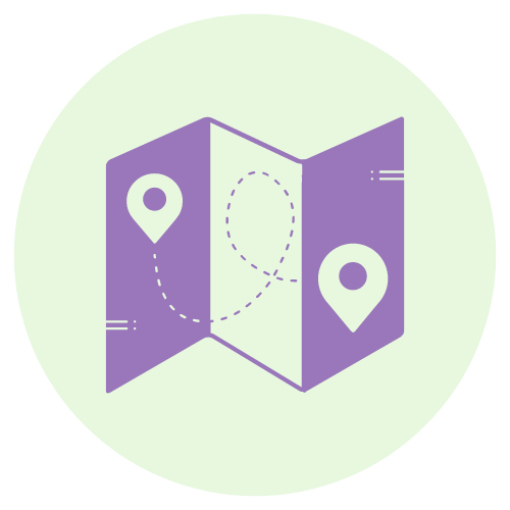
🎬 Webinar: Validating Product Roadmaps With Your Users
Learn how to validate new product ideas and solutions with user feedback in this webinar with Maze
2. Communicate the value clearly to users at each stage
From there, you’ll want to translate all of this product usage data to each segment, ahead of each stage. This way, you’re proactively encouraging users to reach a stage that you know will move them on from new users -> active users -> champions.
This proactive approach guides users through your product and therefore around your flywheel, rather than relying on them to navigate it on their own and become product ambassadors by chance.
Look at everything from your product sign-up process to your onboarding flow. You can communicate the value of each stage using different formats of in-app messages, like product tours, tooltips, walkthroughs, checklists, help menus, and more.
These in-app guides are an unobtrusive way for users to seemingly discover their own path through your product. However, you’ll be filtering their route in a way you know will work for them.
3. Provide a bespoke user experience + eliminate friction
Make sure your tooltip messaging is specific to each individual user, not just the segment they fall in. Use the data you have (names, job roles, company sizes, languages) to determine how to automate and filter down your messaging to provide a scalable yet personal flywheel journey.
Remember those churn points you identified at the start of this process? Now’s the time to initiate in-app messaging that eradicates them, eliminating friction, lifting the user experience, and ensuring users stay in your product (and its wheel).
Custom product tours are a fantastic way to eliminate friction points. Providing a customer with an optional tour upon returning to your product that showcases the appealing features they had previously missed, will give users a reason to stay—quite possibly guaranteeing customer success.
Make a copy of our friction log template to get started quickly. It will help you better understand the pain points your users experience while using your product.
4. Align your whole organization on a user-centric mindset
By now you should have set up user-centric messaging within your product, rather than relying on up-front sales and marketing strategies to get users through the door.
However, just because your Product team has got this methodology down, doesn’t mean the rest of your company is automatically aligned. You’ll need to educate and align the rest of your org on this mindset, especially if you’ve got a cross-functional culture at your SaaS. Being product-led goes beyond simply trying to convince prospective customers to commit.
For example, your customer success team should always think about how to position the product to serve the user so that the user can discover increasing value from your product.
You’re no longer aiming for marketing-qualified leads (MQLs) or sales-qualified leads (SQLs), but product-qualified leads (PQLs).
Start collecting data to showcase the benefits that this new business strategy is bringing to the growth of your SaaS, share insights that other teams can use in their own departments, and start using PQLs to drive product-led revenue.
5. Build, measure, and learn + continuously improve
Lastly, build on the data you collect, learn from it, and optimize. Assess your flywheel and ensure users are smoothly rolling from one section to the next.
If they’re not—if users are stuck in one of the stages, or if they’re churning out of your product altogether—then knuckle down your efforts and adapt your product messaging to deliver them the experience they’re looking for.
Particularly in your first few months of adopting this growth strategy, there’s a high chance you’ll still be onboarding new users that have come through your traditional funnels. Ensure you’re delivering messaging, in-product guidance, and experiences that match up to user expectations.
You can also consider these communication strategies for current users with your advanced feature adoption. You may as well make the most of these new datasets!
Nurture your product flywheel with care
If you want your product flywheel to work and create product champions that are continuously recruiting new users, then your flywheel will need continuous attention and care.
Put the same amount of effort into optimizing your flywheel as you would an ad campaign. You wouldn’t be pumping thousands of dollars into a campaign if you knew the messaging wasn’t hitting the mark.
Maintaining a flywheel follows the same (less expensive!) concept. In its early stages, run a cohort analysis to trial your messaging hypothesis before a full release to your entire user base.
Tweak your in-app messaging copy to match your users’ needs and expectations, give them the resources they need to convert to the next stage of the wheel, and directly address any friction points or blockers.
Your flywheel has the potential to be running at speed, but, just like with driving, you’ll need to go through every gear to get to your maximum speed and true product success. Have patience, build momentum with time, and soon you’ll be rolling with the best results.
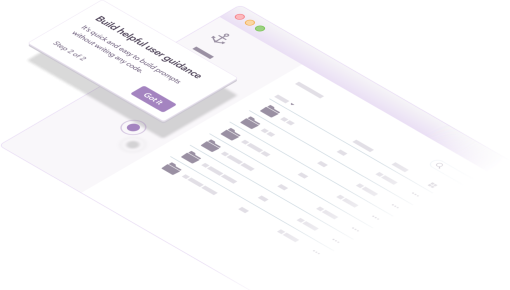
Boost Product-Led Growth 🚀
Convert users with targeted experiences, built without engineering





